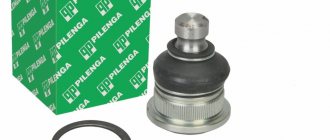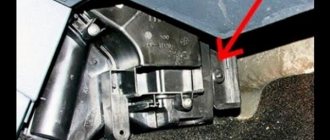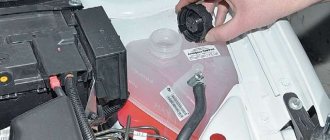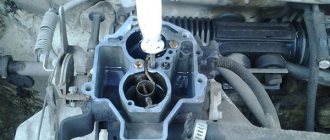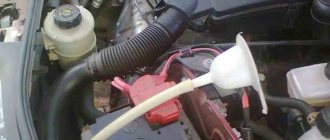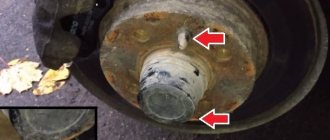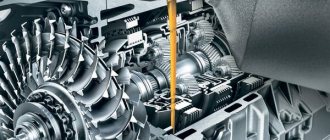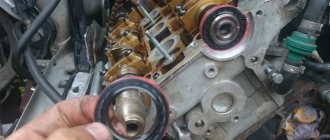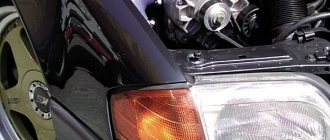The Renault Logan model is equipped with a “classic” type of power steering. This type is usually classified as hydraulic power steering, in which the working fluid is a special power steering fluid (power steering oil). At the same time, changing the Renault Logan power steering oil is considered a mandatory procedure, since during the operation of the car the fluid loses its properties.
As a result, the hydraulic booster:
- can work with increased load and make noise;
- loaded elements are subject to heavy loads and wear out faster;
- The steering wheel may rotate jerkily, with different forces, etc.
To achieve maximum functionality of the amplifier and driving comfort, as well as to increase the power steering resource, the working fluid must be changed, on average, every 50-60 thousand kilometers. You should also replace it immediately if the power steering fluid is dirty or has changed its properties. At the same time, you can service the Renault Logan power steering with your own hands in a regular garage. Read more in our article.
Types of power steering for Renault Logan
Cars are equipped with the following types of hydraulic boosters:
- Power steering with electric pump. The principle of operation of the mechanism is that the lubricating fluid is pumped through a pump. It, in turn, operates thanks to a car generator. The hydraulic “electric booster” operates in certain phases. It is expensive to operate and maintain, and is usually installed on expensive cars.
- Power steering MSV with belt pump. Renaut Logan cars with an engine capacity of 4 and 1.6 liters for 75 and 87 hp. are equipped with just such a mechanism that facilitates the rotation of the steering wheel. The belt wears out over time, but installing a new one is not difficult.
As for the pump itself, a classic device is installed on Logan. It has proven itself well, thanks to stable operation and rare breakdowns.
Tips for using Renault power steering
Many drivers wipe the tank lid, as dust often settles on it. Adhering dust is not a sign of a fogging problem. It is strictly not recommended to do this.
The fact is that inside the cover there is a breather through which air escapes when the hydraulic booster is operating. The air is naturally oily.
When the driver wipes dust on the lid, some of it ends up in the tank, causing contamination of the system. Experienced drivers and craftsmen advise removing the lid and cleaning the lid valve and tank body at least once a year.
You should not hold the steering wheel in the extreme position for more than 10 seconds. This has a detrimental effect on the operation of the pump and quickly destroys the liquid. In this mode, the pressure in the system increases, squeezes out the seals, pipes and spoils the liquid, since under high pressure it begins to overheat.
Interesting on the topic: New Chery Tiggo 8 2022. We are waiting at dealers
Share with your friends!
- Click to share on Twitter (Opens in new window)
- Click here to share content on Facebook. (Opens in a new window)
- More
- Click to share on LinkedIn (Opens in new window)
- Click to share on Pinterest (Opens in new window)
- Click to share on Telegram (Opens in new window)
- Click to share on Skype (Opens in new window)
- Send this to a friend (Opens in new window)
When should you change the oil?
The oil change in the power steering, according to the manufacturer's recommendations, should be carried out every 2 years or 40 thousand kilometers. The frequency of replacement varies depending on the age of the vehicle. Thus, models of 2006, 2007, 2008, 2009, 2010 require more frequent maintenance and replacement of lubricant. For older cars, the optimal mileage will be 25–30 thousand kilometers. As for the more “fresh” models of 2011, 2012, 2013, 2014, 2015, 2016, 2022, these cars are subject to the first replacement at around 40 thousand kilometers. And when buying a used car, experts advise immediately filling the power steering with new lubricant.
If you ignore the manufacturer's recommendations, the responsiveness of the steering wheel will deteriorate over time, and later malfunctions will occur in the entire steering system of the car.
Problems may arise before the recommended fluid change period has expired. For example, when the lubricant in the reservoir has a rich dark color, this indicates the presence of metal particles in it. In addition, this oil smells burnt. Such fluid must be replaced immediately. Also, the lubricant should be changed when the vehicle has not been used for a long time. The reason is the occurrence of condensate in the hydraulic power steering system, which, when mixed with liquid, forms an emulsion and contributes to the loss of all properties of the power steering lubricant.
Signs of end of fluid life
The regulations provide only an approximate frequency for replacing the Renault Logan power steering fluid. Renewal of the hydraulic lubricant is required when the following symptoms appear:
- the steering wheel turns with difficulty, control sensitivity has become lower;
- where the power steering is installed, extraneous noise is heard;
- the amount of power steering fluid has decreased to a minimum;
- there is a smell of burning from the power steering reservoir;
- there were traces of leakage of the unit;
- foam forms in the expansion tank;
- The steering wheel sometimes turns randomly, without driver intervention.
Often problems disappear after updating the lubricant. However, interruptions affecting the operation of the power steering can also be caused by the failure of individual Renault Logan steering components, for example, a pump, rack, distributor and other mechanisms. When repairing any system mechanism, the lubricating fluid must be changed, regardless of how long ago the substance was poured.
The easiest way to check the quality of oil in the power steering system is to pour a little lubricant from the reservoir onto a white sheet of paper.
Darkening and heterogeneity of the composition, as well as the appearance of impurities are indications for replacement.
How to replace?
Before changing the fluid in Renault Logan 16 Kl and 8 Kl, prepare the following tools:
- The oil itself, at least 2 liters.
- Hose and syringe for 20 “cubes”.
- Open-end and socket wrenches.
- A container for draining the waste, with a volume of at least 2 liters.
- The process begins with pumping out the waste liquid from the tank using a twenty-cc syringe.
- All liquid should be pumped out of the expansion tank.
- The vehicle is driven onto a lift, inspection pit or overpass. You can also “hang” the front of the car using a jack or stumps.
- After the tank is empty, the battery and casing are disconnected.
- Next, plastic parts are dismantled, which make it difficult to fully access the steering rack and hydraulic pump pipes.
- Before filling in new oil, it is necessary to inspect the entire power steering system for cracks, signs of leaks and drips.
- If everything is in order with the “internals” of the system, you can begin to remove the hollow tank from its mounts.
- Next, a pipe is disconnected from the removed tank, which goes from the dismantled part to the steering rack. The fitting on which the pipe was placed must be insulated. The fittings located on the tank are also removed.
- An empty container is installed under the reservoir to drain the remaining fluid particles from the power steering.
- The drain pipe differs from the main pipe in having a smaller cross-section.
- The disconnected “main” of the liquid is lowered into a previously prepared container to drain the residue.
After completing all the steps, turn the steering wheel right and left until it stops. This creates enough momentum to manually pump all hoses and reservoirs in the power steering until the fluid drains. To speed up the process, the car engine starts, and thereby the hydraulic compensator is activated. However, this operation should be performed with the participation of an assistant: the power steering pump is not able to function normally if air enters. This can lead to failure and costly repair work. It is necessary to constantly add lubricant to the tank, thereby preventing air masses from entering the system.
The operation is carried out until a crimson liquid flows from the return line. When light oil begins to flow, the replacement process is considered almost complete. The pipe is put on the fitting and secured with a plastic clamp.
New fluid is poured into the power steering reservoir, and the car’s power unit starts. With the engine running, turn the steering wheel right and left as far as it will go, monitoring the oil level in the tank—it will need to be topped up periodically. Repeat the procedure until the oil stops disappearing from the tank and air bubbles disappear on the surface.
After successful completion of the operation, the car’s steering wheel will easily “move” both to the right and to the left. If the expected ease does not appear, you should turn off the engine and carefully check the readings of the power steering pressure sensor. After troubleshooting, turning the steering wheel becomes easier. At the end of the operation, the battery and plastic parts are put in place.
The reason for leaking oil lies in unreliable fixation of pipes and pipes. It is necessary to carefully check the places where plastic ties were used as a fastening element, and secure the elements with greater force.
